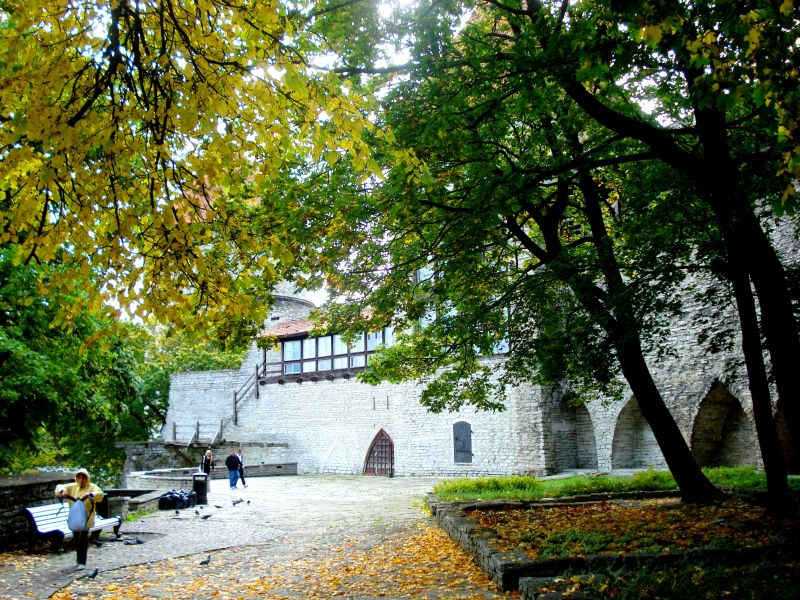Heritage diaries: Discovering the magic of Estonia
Experience walking through Vana Tallinn, Estonia that is sure to take you back in time with its cobblestone streets and medieval structures.

The street ahead was winding and it was an uphill walk. The voices of the crowds were slowly fading as I left the town square behind me. The cobblestones modified my steps as I trekked towards the belvedere. The cool autumn breeze grazed my cheeks and against the setting sun, the yellowing leaves of the elm trees lent the pathway their golden hue. I ran my hands on the stones of the old houses that lined the street. I walked on, conscious of the changing textures of the stones beneath my feet. Moss and ivy had draped the walls of the buildings in this quaint Hanseatic town.
Through the crumbling gateways of the ancient fort wall a new vista exposed itself, a serpentine stairway, ascending precariously towards the mound that would have at one time echoed with lively chatter. The leaves of the trees swayed, dancing to the harmony of the wind and gold fell unto the earth. A gentle drizzle had covered the ground with a carpet of water.
 Framed by golden leaves, the old fort of the city of Vana Tallinn, Estonia (Photo: Jayesh Ganesh)
Framed by golden leaves, the old fort of the city of Vana Tallinn, Estonia (Photo: Jayesh Ganesh)
An old man sat under the eaves of his store-front, with a guitar in his hands and a tune handed down to him by his ancestors. I paused as time stood still. It dawned on me here that I was surrounded by a profoundly haunting presence. It was presence of the past. Death could not prevent the essence of life, past and present, to prevail. The stones, the trees, the wind, the rain and the music had all been there through the ages, as witnesses to the ephemeral lives of the great kings and traders, artisans and the myriad peasants, labourers and paupers.
At a distance from where I stood, I saw a small arched gateway that opened into a large terrace beyond. A couple of travellers were climbing down from there. They smiled at me gently and I reciprocated. Not paying attention to where I was going, I stepped into a muddy puddle and they laughed. The man pointed towards his muck-covered boots. We were all victims of nature’s bounty. It giveth and it taketh away. In this case, my intellectual excitement instantly vanished as I yanked my sneakers and socks to wring them out to dry.
 Glimpse of the old, medieval Tallinn, Estonia. (Photo: Jayesh Ganesh)
Glimpse of the old, medieval Tallinn, Estonia. (Photo: Jayesh Ganesh)
The chill from the wet footwear grew more every minute. I had no intentions of falling sick in this hauntingly romantic town. After about a minute of hopping on one leg, I sat myself down on a dry step ahead trying to retrace my walk from the distant town square to the hill. What materialised now, before my eyes, was a palimpsest of sorts. An eight-century history that had built upon itself, sometimes crumbling down, sometimes accommodating and at other times just reinventing itself.
The uniformly sloping roofs of the town seemed to spring up spires intermittently. In the placid horizontality, there was a certain verticality too in the dynamics of the form of this settlement. The orange and red tiles on the slopes of the colourfully draped edifices lent a shade of uniformity to an otherwise chaotic yet heart-stopping beauty. It felt like peering into the shelves of a French patisserie, the brightly painted buildings lent a taste to the mind’s tongue and indulged the mind’s eye in a moment of profuse flavour. What makes one appreciate such beauty? Rather, a more pertinent question here would be, what force is it that lends such immense beauty to an otherwise ordinary settlement?
I begin to ponder as my reverie led me on to some more wandering. I walked past the small gate ahead with my head lowered, right into a bower. A large tree stood at its centre. Around the tree were smaller trees, shrubs and grasses that covered the large open terrace. The old fort wall defined one edge of the space and hidden behind an old rotunda of the fort, were steep steps that led to a famed cafe. Though I had not walked for long enough, I could seen the centuries unfold right before my eyes. Cold to the bone now, I really needed a sip of something warm.
I climbed on to the rickety wooden cantilever that was clinging desperately to the stone walls. With barely enough width to walk, I moved past the array of small tables. I entered a warmly lit space and discovered a cafeteria. With a glass of warm Hoogvein pressed in my hands, I sat on an empty chair by the candlelit table.
The sun was now setting over this beautiful city and dissolving into the Baltic Sea. The sky changing colours from shades of gold to shades of purple. It was a scene I had witnessed many times before and yet there was something new about it. I took a deep breath and a sip of my drink, looking at the trees of gold, the town of the past, its resilient zeitgeist and listened to the old guitarist who was still partly visible through the now faraway gate. Things do come and go but some things remain the same. Being here in Vana Tallinn, Estonia made me realise – tomorrow will be a new beginning and that today is a new end.
*Disclaimer: This article has been contributed by Jayesh Ganesh, Design Lead, Edifice Consultants. The facts and opinions appearing in the article do not reflect the views of Deccan Chronicle and Deccan Chronicle does not assume any responsibility or liability for the same.
